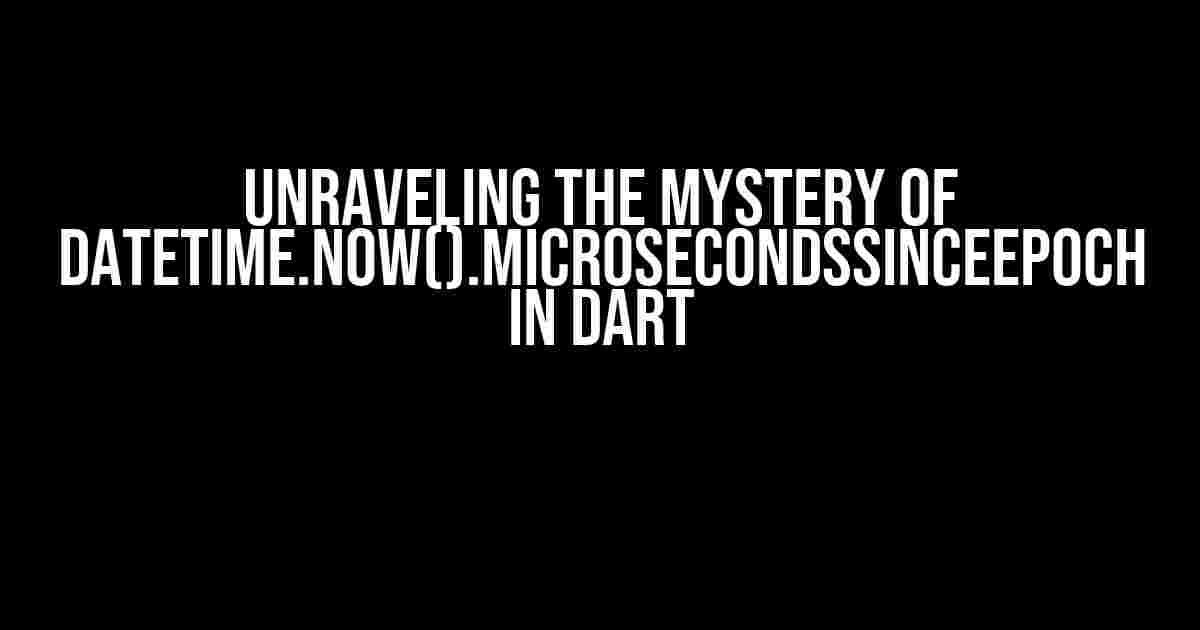As a Dart developer, have you ever wondered how the DateTime.now().microsecondsSinceEpoch function works its magic? Perhaps you’ve used it in your code without fully understanding the intricacies behind it. Fear not, dear reader, for today we’re going to dive deep into the world of date and time manipulation in Dart and unravel the mystery of this enigmatic function.
What is DateTime.now().microsecondsSinceEpoch?
Before we dive into the nitty-gritty, let’s start with the basics. DateTime.now().microsecondsSinceEpoch is a function in Dart that returns the number of microseconds since the Unix epoch, which is defined as January 1, 1970, 00:00:00 UTC. But what does that even mean?
The Unix Epoch
The Unix epoch is a reference point in time that serves as the basis for measuring time in many modern computing systems. It’s defined as the number of seconds that have elapsed since January 1, 1970, 00:00:00 UTC. This epoch is used as a starting point for measuring time in many programming languages, including Dart.
Milliseconds vs. Microseconds
Now, you might be wondering what the difference is between milliseconds and microseconds. While both measure time, they do so at different scales. One millisecond is equal to 1,000 microseconds, which is equivalent to 0.001 seconds. In the context of DateTime.now().microsecondsSinceEpoch, we’re dealing with microseconds, which provides a much more precise measurement of time.
How Does DateTime.now().microsecondsSinceEpoch Work?
So, how does this function actually work? Let’s break it down step by step:
-
The DateTime.now() function returns a DateTime object that represents the current date and time.
-
The microsecondsSinceEpoch property is accessed on the DateTime object, which returns the number of microseconds since the Unix epoch.
-
The microsecondsSinceEpoch property is calculated by multiplying the number of seconds since the Unix epoch by 1,000,000 (since there are 1,000,000 microseconds in one second).
import 'dart:core';
void main() {
DateTime now = DateTime.now();
int microsecondsSinceEpoch = now.millisecondsSinceEpoch * 1000;
print(microsecondsSinceEpoch);
}
In the example above, we first get the current date and time using DateTime.now(). We then access the millisecondsSinceEpoch property, which returns the number of milliseconds since the Unix epoch. To convert this to microseconds, we multiply the result by 1,000.
Use Cases for DateTime.now().microsecondsSinceEpoch
So, why would you want to use DateTime.now().microsecondsSinceEpoch in your Dart code? Here are a few scenarios:
-
Timestamps**: When you need to generate a unique timestamp for an event or transaction, DateTime.now().microsecondsSinceEpoch provides a high-resolution measurement of time.
-
Logging and Debugging**: By using DateTime.now().microsecondsSinceEpoch, you can log events with precise timestamps, making it easier to debug and analyze issues in your application.
-
Synchronization**: In distributed systems, DateTime.now().microsecondsSinceEpoch can be used to synchronize clocks and ensure that events are processed in the correct order.
Common Pitfalls and Considerations
While DateTime.now().microsecondsSinceEpoch is a powerful tool, there are some gotchas to be aware of:
| Pitfall | Description |
|---|---|
| System Clock Drift | The system clock on the device or machine running your Dart code may drift, causing inaccurate timestamps. To mitigate this, consider using an external time source or syncing with a reliable clock. |
| Leap Seconds | Leap seconds can cause issues with timestamp calculations. Dart’s DateTime class takes leap seconds into account, but it’s essential to be aware of their impact on your application. |
| Time Zones | When working with DateTime.now().microsecondsSinceEpoch, keep in mind that the resulting timestamp is in UTC. If you need to work with different time zones, make sure to adjust the timestamp accordingly. |
By understanding these potential pitfalls and taking them into account, you can ensure that your code uses DateTime.now().microsecondsSinceEpoch accurately and effectively.
Conclusion
In conclusion, DateTime.now().microsecondsSinceEpoch is a powerful tool in the Dart ecosystem that provides a high-resolution measurement of time. By understanding how it works and its use cases, you can leverage this function to build more robust and accurate applications. Remember to be mindful of potential pitfalls and considerations, and you’ll be well on your way to mastering the art of date and time manipulation in Dart.
So, the next time you find yourself wondering how DateTime.now().microsecondsSinceEpoch works its magic, you’ll be equipped with the knowledge to tackle even the most complex time-related challenges.
Frequently Asked Question
Ever wondered how the DateTime.now().microsecondsSinceEpoch exactly works in Dart? Let’s dive into the details!
What is microsecondsSinceEpoch in Dart?
MicrosecondsSinceEpoch is a property of the DateTime class in Dart that returns the number of microseconds since the Unix epoch, which is January 1, 1970, 00:00:00 UTC. It’s a way to represent a specific point in time as a large integer value.
How does DateTime.now().microsecondsSinceEpoch get the current time?
When you call DateTime.now(), Dart uses the underlying system’s clock to get the current time. This is usually done using the operating system’s API, such as the `gettimeofday` function on Unix-like systems or the `GetSystemTime` function on Windows. The `microsecondsSinceEpoch` property then converts this time into the number of microseconds since the Unix epoch.
Is DateTime.now().microsecondsSinceEpoch accurate?
The accuracy of DateTime.now().microsecondsSinceEpoch depends on the underlying system’s clock. Most modern operating systems have clocks that are accurate to within a few milliseconds. However, there can be some variability depending on the system’s load, network lag, and other factors. If you need high-precision timing, you may need to use specialized libraries or hardware.
Can I use DateTime.now().microsecondsSinceEpoch for time-based operations?
Yes, you can use DateTime.now().microsecondsSinceEpoch for time-based operations, such as calculating elapsed time, scheduling tasks, or generating timestamps. However, keep in mind that the resolution is only up to microseconds, so if you need higher precision, you may need to use alternative methods.
Is DateTime.now().microsecondsSinceEpoch platform-independent?
Yes, the DateTime.now().microsecondsSinceEpoch property is platform-independent, meaning it will work the same way on different operating systems, including Windows, macOS, and Linux. This is because it relies on the underlying system’s clock and the Dart runtime’s implementation, which abstracts away platform-specific differences.

